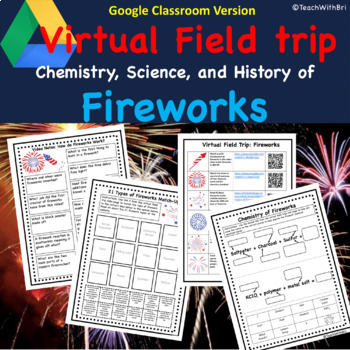Fireworks Chemistry and History Virtual Field Trip for Google Classroom
- Google Drive™ folder

What educators are saying
Also included in
- Learn all about the major holidays this year with your class in this no prep mega bundle! Bundle includes the holidays of: Christmas, Hanukkah, Kwanzaa, Valentine's Day, Ground Hog's Day, Easter, Halloween, MLK Day, Winter Solstice, Thanksgiving, Macy's Day Parade, and so much more! Ideal for upperPrice $49.95Original Price $67.65Save $17.70
Description
Learn all about the science, chemistry and history of Fireworks with your middle or high school class! Perfect lesson for everyday science use, sub plans, or 4th of July, independence day, or New year's Eve! Learn the chemistry and science behind the Chinese invention and make your lesson go off with a bang!
Take a Virtual Field Trip:
- Watch a video fly over of a fireworks show in 360 VR
- Explore the chemistry behind fireworks with a video
- Read and learn all about different types of fireworks
- Watch a video from TED-Ed about the history of fireworks in Ancient China
- Try a simulator to create your own firework show
- Watch and read to learn about the chemical composition of fireworks
This is the digital version meant for use with Google Classroom and Google Apps. To find this same exciting resource in PDF printable form (ideal for shared device classrooms or using at one screen in the front of the classroom) please see my store TeachWithBri
This product includes all of the following plus more:
- Free product code for teachers (a 2 Dollar Value from my store)
- Teacher instructions
- Differentiation ideas for students
- Essential questions for lessons (can be posted throughout lesson or given as an assignment task for students) Questions align to Bloom's Taxonomy Levels
- Student instructions
- Virtual Field Trip go page (links to field trip activities) lots of great links with QR!
- Field trip overview summary worksheet page (before attending page)
- Pre-assessment True or False student learning check
- Video questions page
- Match-up task for video
- Website note taking fill in the blank worksheet for virtual field trip link
- Chemical equation worksheet page for fireworks
- Types of fireworks and terms match-up
- Video questions- History of fireworks from Ancient China
- Assessment (field trip check)
- Compare fireworks and firecrackers Venn diagram task
- Writing task- newspaper article about the discovery of fireworks
- Website notes- Fill in the blank, fireworks
- Snapshots of firework types and simulator show diagram task
- Writing summarization task
- Summary worksheet page
- Assessment of learning (5 question quiz page for students)
- Grading Rubric for teachers
- Student self assessment grading rubric
- True or False learning check (for students to post assess learning)
- Teacher Assessment key
- Teacher true or false answer key
- Video questions answer key for teachers
- Website questions match key for teachers
- More Answer Keys
- Terms of use and credit pages
- Connect with me for more pages!
All of my lessons are designed to work through the levels of learning according to Bloom's Taxonomy. Lessons start with information given to students through field trip links and then student learning works through the Bloom's levels to help guide and build learning. Students first show knowledge with basic recall questions from video answer question worksheets. Next students demonstrate comprehension by retelling key ideas with guided worksheet questions. Application is included with allowing students the opportunity to show what they have learned in worksheet tasks. Next students move to the analysis then synthesis stage of Bloom's Taxonomy by creating and synthesizing their own products or inventing using what they learned. Last students evaluate by both evaluating the content they created with specifically designed worksheets then evaluating their own work with self-assessment opportunity included.
Check out a freebie from this series and other great freebies from my store to see the types of activities included in virtual field trips.
Love this lesson? Be sure to check out more great resources from my store and FOLLOW ME FOR WEEKLY FREEBIES! (That's right, I strive to post a new free product each and every week, so be sure to click the star to follow me above!) Follow along with my lessons and see great learning in action on Pinterest at TEACHWITHBRI12
*Please note the places in this exciting field trip are in no way associated with TeachwithBri or TeachersPayTeachers and are independent great places and sites. They are meant to be used as a resource with the exciting lessons and activities in this product and are in no way my own work or property.






